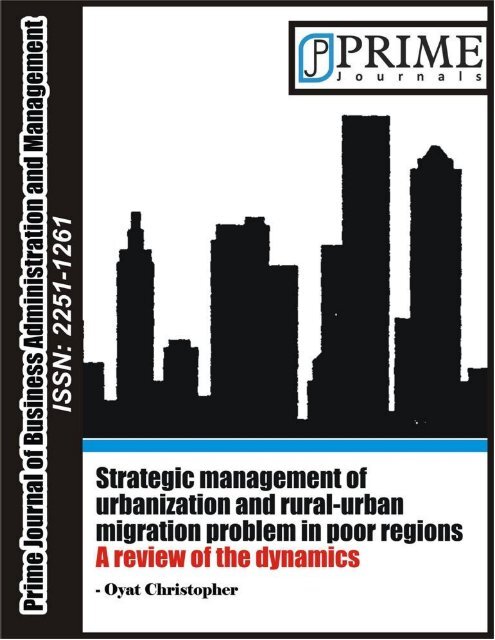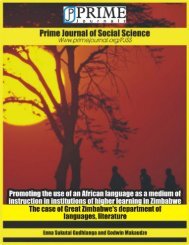Oyat (607).pdf - Prime Journals
Oyat (607).pdf - Prime Journals
Oyat (607).pdf - Prime Journals
Create successful ePaper yourself
Turn your PDF publications into a flip-book with our unique Google optimized e-Paper software.
<strong>Prime</strong> Journal of Business Administration and Management (BAM)ISSN: 2251-1261. Vol. 3(6), pp. 1043-1046, June 26 th , 2013www.primejournal.org/BAM© <strong>Prime</strong> <strong>Journals</strong>Review PaperStrategic management of urbanization and rural urbanmigration problem in poor regions: A review of thedynamics<strong>Oyat</strong> ChristopherSenior lecturer, Department of Development Studies, Gulu University, Uganda.Accepted 15 th June, 2013Policy makers and technocrats in charge of urban authorities should appreciate the fact that urbanization andrural-urban migration phenomena is real in developing countries, and the problems and challenges embeddedtherein should be strategically and proactively tackled. It is emphasized that there should not be discriminationby way of compelling without proper plan the urban poor to recede and occupy rural areas as if towns andcities are meant for only the well-to-do people. Equally vital is the fact that development actors such as nongovernmentalorganizations and United Nations agencies should unequivocally render capacity buildingsupport with similar magnitude provided to the ruralites. All stakeholders in towns and cities have obligationsto ensure that urban livelihood services and the general infrastructures are improved for the mutual benefit ofthe entire town dwellers.Key words: Urbanization, migration and poverty.INTRODUCTION AND BACKGROUNDUrbanization is looked at as a process by which anincreasing proportion of the population becomesconcentrated in urban centres. The trend in the worldshows that urban centres and urban population havebeen increasing tremendously, for example in 1800, therewere only 3% of the population living in urban areas. By1900, the population had increased to 13%. In 2002, it isdocumented that world urban population stood at about50%. In the case of Uganda, and in accordance with2002 census, 12% of the total population lived in urbancentres.Table 1 clearly shows that there has been a generalstudy rise in the urban population worldwide. But ofspecific note is the trend in less developed regionsespecially in Africa and Asia of late. Whereas the worldurban population and that of more developed regionshave been increasing since 1950 and projected as shownabove, come 2025, it is interesting that the rate ofurbanization and rural-urban migration appears to befaster in less developed regions of the world (Todaro,2003).Urban scholars and development economists havenoted that urban population generally engage in nonagriculturalactivities like industrial, institutional andcommercial activities. And because of high urbanizationand population growth world over, there has been atendency to destroy objects, degrade soil, cut trees andcultivate more land to meet farmers’ demand of the everincreasing urban population.To meet the needs of burgeoning urban populations,stimulate both urban and rural development and achievemillennium development goals (MDGs), planners andpolicy makers should reconsider some of their biasesagainst urban growth. The world over, it is evident thaturbanization and rural urban migration can play a positiverole in social and economic development (UNFPAReport, 2007). Historically, the statistical associationbetween urbanization and economic growth has beenstrong. Today, cities and towns generally have greaterpotential for sustained development than rural areas,especially when look at the potential for reducing poverty.It is a fact that cities and towns are the main sites foreconomic growth in most countries, and do account for ahigh share of national economic production. It is arguedthat countries that are highly urbanized tend to havehigher incomes, more stable economies, stronger
<strong>Oyat</strong> 1044Table 1: Urban population in major world regions from 1950 – 2025 (in millions and billions)Region 1950 1960 1970 1980 1995 2000 (a) 2025 (b)World 724 1012 1352 1807 2584 3208 5065More developed regions 449 573 698 834 875 965 1040Less developed regions 275 439 654 972 1709 2101 4025Africa 32 50 83 133 250 331 804Latin America 68 107 162 241 358 431 601Asia 218 342 407 596 1101 1291 2615Source: United Nations, patterns of urban and rural population growth, New York, 1980.institutions and are better able to withstand the volatilityof global economy (UNFPA, Report 2007).It is commonly assumed that rural - urban migrationmerely redistributes poverty from the country side to thecities and towns. Yet, social mobility commonlyaccompanies migration, and poverty rates have beendeclining in both the rural and urban areas of manycountries. In Bolivia, urbanization accounted for 28.3% ofthe 1.2 percent reduction in the national poverty levelduring the 1999 – 2005 period; 17% of the Brazil’s 5.1%poverty reduction between 1999 and 2004 was similarlydue to urbanization and rural –urban migration. InNicaragua, urban and rural poverty levels hardly changedat all between 1998 and 2001; yet the national povertylevel fell over half a percentage point as a result ofurbanization.Although this descriptive exercise does not provideconclusive evidence as to whether urbanization has anindependent role in promoting poverty reduction, it doessuggest that given the right conditions, it can be adynamic component of national poverty reductionprocess, rather than being a mere escape valve for ruralpoverty.The reluctance of policy makers including a bid toaccept urbanization has been a barrier against the flow ofadvances promoted by urban social movements. Inrecent years, local organizations of the urban poor(OUPs) and NGOs have made remarkable headway incollective efforts to improve housing infrastructure andgeneral services thereby greatly alleviating and reducingurban poverty. Their efforts are being greatly recognizedtoday; the 2006 United Nations Habitat Conference was,in many ways, a celebration of their success. Yet localcommunities have often had to overcome obstacles putup by local and national authorities, when a moresupportive approach could have made a crucialdifference! To help urbanization and rural urban migrationmove in the right direction, policy makers need to revisethe assumptions that underlie their anti-urban bias. Theyshould be able not only to move with the flow of thecurrent actions adopted by a number of nations ininfrastructural development, but also to direct the processof socio-economic development towards improving theurban habitat and reducing poverty.Trying to lock out the massesIt is documented that several national governments indeveloping countries have tried to keep or restrict therapid expansion of urban settlements for the poor by;- Ambitious schemes to retain people in rural areas or tocolonize new agricultural zones; and- Regulating urban land use, backed up either byevictions or more frequently by denying essentialservices such as water and sanitation.The arguments that portray excessive rural-urbanmigration as a cause of urban poverty are typically basedon a number of misconceptions as follows:1) Rural-urban migrants are primarily responsible forurban poverty;2) Focusing on urban poverty can detract attention fromrural development;3) Population growth in cities and towns is what causesslums;4) The poor are a drain on the urban economy;5) Migrants would be better off remaining in rural areas;and6) Rural –urban migration policies can limit urban growth(UNFPA, 2007).Policy makers and technocrats alike should note that wellintentioned mobility is a strategy that several householdsand individuals adopt to improve their lives and to reducerisks and vulnerability in society. In many regions peopleare forced to leave rural areas due to, for example,environmental changes, insecurity and the search forbetter livelihood conditions of engagement. Urbanauthorities and central Governments should strengthentheir capacities to respond to the pressures caused byrapid urbanization. Particular attention should be paid toland management in order to ensure economical landuse, protect fragile ecosystems and facilitate the accessof the poor to land in urban and rural area alike withoutdiscrimination.Study approachThis study benefits heavily from the fact that theresearcher had worked as central Government appointedChief Executive Officer (Town Clerk) of various urban
1045 Prim. J. Bus. Admin. Manage.authorities in Uganda from 1992 – 2001. As a technocrat,the researcher had been able to work with variousstakeholders including policy makers, developmentpartners, central government officials and the localpopulation to ensure that attendant aims and objectivesof urban authorities could be met.Secondly, this research work benefits from relevantcontemporary literatures on urban growth anddevelopment, urbanization and rural-urban migration, aswell as from secondary data from United Nationsagencies. On top of this, the researcher is a teacher ofurbanization and industrialization at Gulu University. Allthese sources of primary and secondary data havegreatly helped to sharpen not only exposure but properunderstanding of the notion of strategic management ofurbanization and rural urban migration in poor countries.Strategic areas to focus on in poor countries bypolicy makers and technocratsIt is important not to stop rural population from moving toinhabit urban areas. The tendency of artificiallyseparating rural areas from urban zones can afford tolead to a fundamental backlash. It is important to haveour facts right. The history of attempts to control ruralurbanmigratory flows is couched in frustration. Mostcentrally planned economies during the cold war era suchin Russia, China and North Korea attempted it particularlyby limiting migration to the capital cities and towns withlittle or no effect. Many post colonial governments inAfrica and Latin America have inherited the draconianmeasures of colonial regimes to prevent rural-urbanmigration. It is fact that efforts to redirect migration flowsand to stop urban concentration often reflect technocrats’lack of understanding of why migrants move. Explicitgovernment policies systematically attempt to promotede-concentration. By contrast, their implicit and policies,which generally conform to market forces, almostinvariably strengthen concentration, to the contrary(McGranahan and Satterthwaite, 2006).Arising from this lop sided approach, it has led to theobservable fact that societies that allow the freemovement of people within their borders are likely to seea reduction of poverty in rural areas. We should note thatpeople simply do not move from rural to urban areas forthe sake of it. There are clear and well meaning pullfactors generally. To this extent, those who attempt tocontrol migration or limit reverse movements to townsand cities, are likely to see little change or experiencedeterioration in living conditions of people. We should bereminded that internal movements of population weretightly controlled in both China and Viet Nam until thereforms from 1978 and 1986 respectively. Arising fromsuch reforms hinging on liberalization and free mobility oflabor, poverty in these countries has sharply droppedover the subsequent decades (Tannerfeldt and Ljung,2006).Governments of developing countries should examineissues associated with shelter needs of the poor in urbanzones. Overcrowding, inadequate infrastructure andservice provision, insecurity of tenure, risks from naturaland human made hazards, exclusion from the exercise ofcitizenship and distance from employment and incomeearning opportunities are all linked together. Shelter is atthe core of urban poverty. Much can be done to improvethe lives of people through better policies in this area. Infact countries in developing world should come out withwhat is called national shelter plans discreetly andproperly developed and consistently implemented. Policymakers and technocrats alike should note thatinadequate shelter provision or not proactively takingaction at all is at the root of urban poverty. The persistentreluctance of policy makers to accept urban growthleaves the poor to fend for themselves in disorganizedand merciless land and housing markets. Beingpowerless, the poor are forced to live in inhabitable orinsecure areas where even minimal services such aswater and basic sanitation are unlikely to materialize.Dealing with the rapid doubling of the urban populationin developing countries requires vision and a moreeffective and efficient approach. To have a chance toimprove their lives, the poor need access to affordableand serviced land on which to build their homes andreach other services. With that as the cornerstone, theycan start to build the rest of their lives. Thus, a criticalinitiative for the medium and long term is to provideaccess to shelter through proactive policies with regard toland ownership, good regulations, financing and servicedelivery. But we should note that providing poor peoplewith minimally serviced land is not an easy solution.Given the voracity of the economic interests prevailingand involved, the murkiness of titles in many developingcities and towns, and the uncaring responsiveness andability of informal land markets to emphasize profit byexploiting the poor – to this extent, dealing in land usehas always been fraught with difficulties. Not only theintended beneficiaries, but local and nationalgovernments generally have very limited resources andwill to effectively and efficiently chat for the way forward.Government bureaucrats generally have little appetite forthe taking tough political and well meaning decisions thatthe issue requires.One specific angle of great concern that should belooked at is that to do with availability of land for the poorin the face of rapid urban growth. The problem is not somuch the shortage of land or the number of poorurbanites but rather their restricted access to servicedland and housing because of distorted land markets.Servicing already settled areas costs more than providingserviced land on unoccupied sites! Yet public authorities,pleading insufficient funds seem to find smallerinvestments in expost facto programs more appealingthan well planned proactive policies. Much could be done
<strong>Oyat</strong> 1046to improve the situation for instance by enacting specialregulations for the provision of adequately serviced landfor low income groups. Cities and towns could financeurban development by taxing increases in land valueresulting either from public investment in local urbaninfrastructure or services, or from the redefinition of landuses towards more profitable ones, such as changesfrom rural to urban, or from residential to commercialuses. The urban poor tend to be treated as if they arepassive in the production and consumption of land, andyet they have some capacity to pay for land, despite theirlow and unstable incomes. Indeed, the poor already payvery high prices for the housing they find through theinformal market. This capacity to pay could be bettermobilized through formal regulations and provision ofplots of land in their favor.The urban poor may be linked to potential incomegenerating activities such as soft credit facilities. But thisrequires that such poor individuals should be facilitated orenabled to form groups of about 10 – 40 for easytargeting and management, and linkage to resources.Urban authorities and development partners shouldmobilize and sensitize such groups including enablingthem acquire basic business skills in resourcemanagement before providing soft kind of revolving fundsto the respective identified groups. The operation of eachand every group should be closely monitored andevaluated by the funding agency. Continuous supportshould always be given to the respective groups so thateach would continue to rise and fulfill the attendant setobjectives.McGranahan GDM, Satterthwaite D (2006). Land andservices for the urban poor in urbanizing countries,London, Longman.Tannerfeldt G, Ljung P (2006). More urban, less poor: Anintroduction to urban development and management,London, JIDA.UN-Habitat (2006). State of the World’s Cities 2006/2007:The millennium development goals and urbansustainability, London, Earth scan.United Nations Fund for Population Activities (2007).State of world population, New York, UNFPA.UNFPA (2011). State of Uganda Population: Populationand reproductive health – Broadening opportunitiesfor development, Kampala, UNFPACONCLUSIONSUrban authorities and central governments should desistfrom the temptation and predisposition of planning andfocusing on the well-to-do in towns and cities in poorcountries. In any case in developing countries we havemore poor people living in towns and cities than the rich.The philosophy of good governance demands that thosein authority should majorly plan and focus more attentionand resources in favor of the disadvantaged than the wellto do class of people. It is a fact that good governancecan be judged in terms of how well an institution hasmanaged scarce resources in favor of the needy, but notin terms how well it has done to improve the lot of thealready well to do class of people. To this extent, itmeans that more resources and attention should be morein favor of the disadvantaged.REFERENCESGeorge ST, Vinod T (1987). The economics ofurbanization and urban policies in developingcountries, Washington DC, World Bank.Michael PT (2003): Economic development, London,Longman.





![See Full Article [pdf] - prime journals limited](https://img.yumpu.com/49292987/1/190x245/see-full-article-pdf-prime-journals-limited.jpg?quality=85)



![See Full Article [pdf] - Prime Journals](https://img.yumpu.com/44526114/1/190x245/see-full-article-pdf-prime-journals.jpg?quality=85)


![See Full Article [pdf] - prime journals limited](https://img.yumpu.com/42270022/1/190x245/see-full-article-pdf-prime-journals-limited.jpg?quality=85)
![See Full Article [pdf] - Prime Journals](https://img.yumpu.com/41607332/1/190x245/see-full-article-pdf-prime-journals.jpg?quality=85)
![See Full Article [pdf] - Prime Journals](https://img.yumpu.com/41231982/1/190x245/see-full-article-pdf-prime-journals.jpg?quality=85)

